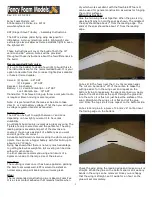17
(&(
Front Tuck:
A front tuck can be induced by strongly pulling the A-risers or by sudden, heavy
turbulence. The entire leading edge spontaneously collapses. Gentle braking on both
sides will reduce the lateral pendulum motions and simultaneously accelerate re-
inflation.
The Icon generally self recovers from an initiated front tuck. When having a very large
front tuck, a frontal rosette can happen (the wingtips move forwards: shaping a
horseshoe). Gentle braking can avoid this deformation.
A quick recognition of the situation and a quick reaction by braking on both sides as
long as the collapsed wing is behind the pilot helps the recovery and limits the altitude
loss.
WARNING!! As already described the Icon is a paraglider with shark nose airfoils and
with more backwards positioned A suspension points. These airfoils and postion of A
suspension points give more inherent stability and offers more resistance against
collapses. It wasn`t necessary to feature the Icon with special folding lines to perform
the manoeuver. But nevertheless the accelerated symetric collapse must be performed
correctly in a propper way and this preferably by safety trainings.
.
It is important to take the two outermost A-lines together (approx 10 cm above the Rapid
gliders) firmly in your hands. Do not use the cetnral A-lines! At the beginning of pulling
the move (in the direction of pilot`s body ) must be slow and after the move of cca 5 cm,
it can only be strongly pulled down. By this way the leading edge collapses properly
over its span. In case you use all A risers for this manoeuvre and you do it without initial
pulling it may happen that the leading edge collapses over all depth in the center of the
wing. The result may be an asymetric opening and the risk of a big cravat increases!
Parachutal stall (deep stall):
In a parachutal stall the paraglider has no forward momentum combined with a high
descent rate. A parachutal stall can be caused by, among other reasons, a too slow exit
from a B-line stall or severe turbulence. Porous canopies (UV influence) or canopies out
of trim (stretched or shrunken lines) are much more susceptible to a parachutal stall and
therefore should not be flown. These are some of the reasons regular checks should be
carried out on your glider. A wet canopy or temperatures below zero centigrade (0°C)
may also cause a stable parachutal stall. The Icon will usually spontaneously recover
from a parachutal stall within 2-3 seconds. If the canopy remains in a parachutal stall, it
is sufficient to gently push both A risers forward or to push the accelerator.
Attention! If brakes are applied while in a parachutal stall, the glider may suddenly enter
a full stall!
If a parachutal stall occurs on landing approach, the pilot should prepare for a hard
landing and make a parachute roll landing. In close proximity to the ground, due to the
forward surging pendulum effect, a recovery may be more dangerous than a hard
landing in parachutal stall.


















